Copyright April 1 2002, S Hartwell
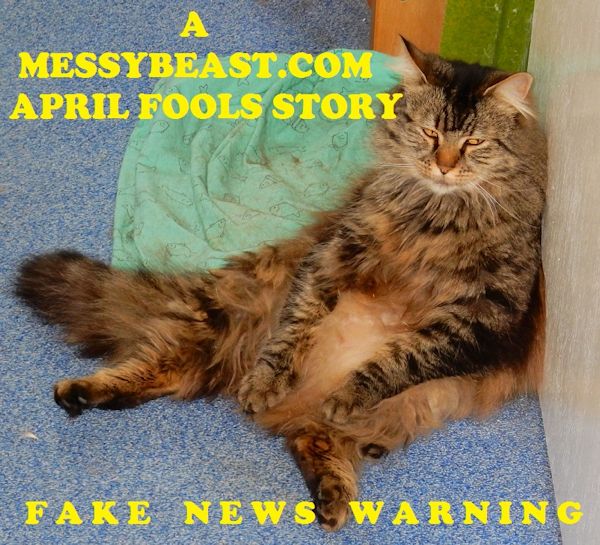
THE GENETICS OF GREEN
Copyright April 1 2002,
S Hartwell 
Green is a relatively new colour in cats and has not yet been seen on the showbench. Breeders have been working to understand the genetics of this colour since it first appeared in stray cats in 1995 and 1996, with a view to developing a green breed. This could then be used as an outcross in order to introduce the colour into existing breeds. The working name for the breed is "Danish Green" since the first green cat occurred in Denmark. None of these photos are Photoshopped.
THE FIRST GREENS

The first green cat was born in north-west Denmark in 1995. Named "Miss Greeny", the kittens was found in a hayloft and it immediately caused a sensation. The kitten's fur and claws were green and the colour could not be washed out. The colouration was initially attributed to a mutation, however a vet attributed it to a copper patina, apparently present since birth, from the tip of its fur to the hair follicles. The high copper content in the local water supply was apparently causing a verdigris effect, but would normally be toxic. Miss Greeny's unusual colour faded as new fur grew through, apparently because she was no longer exposed to copper-rich water.
The appearance of Miss Greeny was reported in newspapers and journals around the world.
Green feline puzzles
scientists, pleases owner
Albany DIocrat Herald Newspaper
COPENHAGEN, Denmark (AP) - Something's green in the state of Denmark. It's a kitten, much to the puzzlement of veterinarians who've tried to wash out the cat's grass-green tint.
"Experts from the university hospital said that the colour also appears in the hair follicles," Pia Bischoff, the kitten's owner, said Monday. "It could be a metabolism defect."
The two-month-old feline, called Miss Greeny, is all green except for a grey spot on the back, she said. Samples of the kitten's green hair have been sent to Copenhagen's university hospital for testing. Other than the unusual shade, Miss Greeny is a normal, frisky feline.
"She is bobbing around, playing and being adorable like all other kittens," said Bischoff who lives in Dybvad, 160 miles northwest of Copenhagen.
Knalgroene poes naar museum
A Dutch report.
Time Magazine
24 November 1995
DYBVAD: Puss cats come in various sizes and many hues, but never green. That is, until Miss Greeny, a verdigris-colored Manx-blend kitten, was born 2 months ago in a hayloft in this Danish town. Researchers at Copenhagen University hospital who have inspected fur samples say even the follicles are pigmented, indicating that the color comes from within. Says Knud Steensborg, a local veterinarian who has examined Miss Greeny: " At first I suspected a prank. But there's no doubt: this is a zoological sensation." Steensborg believes the odd coloration is the result of a disorder in the kitten's copper metabolism.
LEUTE (Fräulein
Grünlich)
Berlin Online, 15.11.1995
Pia Bischoff - Wegen des grünen Fells ihrer Katze hat die Dänin aus Dybvad ihr zwei Monate altes Tier "Fräulein Grünlich" genannt. Veterinäre, die ihren Augen nicht trauen wollten, haben vergeblich versucht, die Farbe auszuwaschen. Es könnte sich nach Meinung von Tiermedizinern um eine Stoffwechselkrankheit handeln. Ansonsten ist "Fräulein Grünlich" eine normale, verspielte Katze.
On 26th November 1995, five-year-old Kristinne Bischoff appeared with Miss Greeny during a six-hour weekend appearance at the Denmark's Aarhus Natural History Museum. Danes packed the museum to get a glimpse of the green kitten.
By 1996, having appeared at cat show and other venues, the kitten apparently vanished from the public gaze.
To the surprise and delight of cat fanciers, although Miss Greeny's green colour initially appeared to fade, as her adult coat grew in, the colour intensified. Further analysis of hair samples showed that the colour was due to mutated pigment cells in the hair rather than by a patina of copper as initially thought. By that time, though, Miss Greeny had been spayed and the gene appeared to be lost. Due to the cat's temperament, her owner decided not to exhibit her unique pet again. There were further reports of green kittens in 1995 and 1996, including one in the Netherlands, but none were authenticated.
A year after Miss Greeny's birth, her barn cat mother, had produced further unusually coloured kittens, presumably fathered by Miss Greeny's father (the dominant male in the area at that time). Of the three kittens (one stillborn), two male kittens had the same distinctive green colour as Miss Greeny. The intention was to test-mate one of these to Miss Greeny, but she had already been spayed. The two kittens were adopted by an English cat fancier Maria Goddard who worked at Copenhagen University. Mrs Goddard also adopted their mother in order to mate the male kittens back to her. She attempted to trap the presumed sire, but he was later found dead on a nearby road.
As with Miss Greeny, the colour of the two green males initially faded before growing back with greater intensity. The one with the best developed colour, "Mister Greeny" (Herr Grünlich), was mated to his mother in 1997, producing two litters. Among the kittens was an intensely green female whom Mrs Goddard named "Grunhilde". The other male kitten from the original litter, Loki, was acquired by Mrs Agnetha Fredrikson to be test mated to other cats to determine the mode of inheritance. By using purebred cats of known genotypes (i.e. breeders knew what genes their cats carried and for which colours) she could determine whether green operated as a new colour entirely or as a modifier of other colours. He was mated to a variety of longhair and shorthair females, giving rise to selfs, tabbies, smokes and tipped cats. Many of his progeny played important roles in the later breeding program.
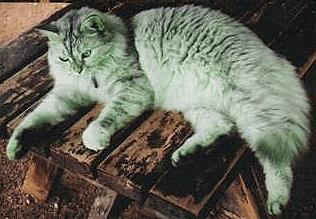
Mrs Goddard's Grunhilde and her half-brother Loki were to become the founders of a line of green cats. Mrs Goddard realised she had two main choices: develop a breed which bred true for the green colour or permit her green cats to be used as outcrosses for other breeds into which the new colour could be introduced. She was well aware that a Green Persian would be particularly attractive. She decided initially to develop the cats as a true-breeding strain, using European Shorthair outcrosses to improve conformation and in order to understand the genetics of green. Much of the genetics groundwork had already been done by Fredrikson.
If green operated as a new colour carried on the same allele (section of DNA) as an existing colour, it would either be dominant to, or recessive to, that existing colour. For example it might be a genetic alternative to black (a mutant version of black). Most genes are inherited in pairs. If it was a dominant gene, the cat only needed to inherit one copy of the gene to give it the green colour. If it proved to be recessive, a cat had to inherit two copies of the gene to be a green cat (the complication is that there are several genes on the black allele and some genes are more dominant than others in a sort of sliding scale effect).
If it was a modifier, it would be carried on a different allele. The best example is the dilute modifier. If a black cat inherits the dilution gene alongside the black gene, you get a blue (grey) cat. If a red tabby cat inherits the dilution gene alongside the red gene, you get a cream tabby cat. Dilution gives a washed out version of the cat's colour. If it was a modifier, it might cause different shades of green depending on what other colour genes the cat inherited. For example, it might modify black into dark green, grey into light green.
These are all considerations which any breeder has to bear in mind when developing a new trait - how that trait is inherited and how it interacts with other traits.
NOT GENETICALLY MODIFIED
When the green cats were first exhibited, some cat-lovers accused breeders of dabbling with genetically modified (GM) cats and cited the examples of "CC" the cloned kitten (cloning is not the same as GM) and fluorescent white rabbits produced by inserting a jellyfish gene into a fertilized rabbit ovum.

Breeders emphasise that the green cats are neither GM nor clones, but were developed from a chance mutation in exactly the same way as breeds such as the Munchkin. GM is expensive and currently limited to laboratory animals and experimental livestock. Following the GM fluorescent rabbit, magazines frivolously suggested possibilities such as calico cats with red, black and fluorescent patches. Mutations occur all the time, but relatively few are viable and even fewer are both harmless and eye-catching.
"Only the colour is affected," says American breeder Robin Schmidt, "As far as anyone can tell, this mutation has no side-effects. People are naturally sceptical because it's so different to what they are used to seeing in terms of feline colouration. When Siamese cats first arrived in the West, they were described as nightmarish and unnatural because they were very different to the common perception of what a cat should look like, but they were everyday cats in Thailand! In twenty years' time, no-one will give the new colour a second thought."
According to Andrea Thornton, who owns two female green longhairs, the cats are completely normal. "Mine have access to an outdoor run, and when they sit among the shrubs it is impossible to see them. On several occasions I've been certain they have escaped, only to find them sleeping between bushes. My neighbour is convinced I've dyed them! I'm planning to mate them this spring and I'm really looking forward to showing him the kittens and proving that they really are born that colour."
Dev Smith is another fan of the green kitties. He owns Green Ginger, one of very few non-breeding greens due to cryptorchidism (undescended testicles). "I was forever explaining to friends that Green Ginger is naturally that colour and that I haven't dyed his fur. They are divided into those who think the colour is awful and those who want one just like him. He's just a very sweet kitty who doesn't know what a stir he causes when people see him."
Others are not so enthusiastic. Some animal welfare workers have already spoken against breeding the new colour, "People might try to dye cats green, either because they can't afford the real thing or because there is money to be made from selling fake green cats. We don't recommend using any form of dye on cats because they are likely to lick it off."
Andrea Thornton disagrees. She says the same could be applied to any unusual or uncommon breed, "It is ludicrous to say 'don't breed these cats'. The green gene is out there, it is a recessive gene. Recessive genes don't go away, they just stay hidden in the gene pool and pop up at a later date."
INHERITANCE OF GREEN
Green appears to be a mutant allele of black producing a green pigment called chloromelanin instead of eumelanin. It is recessive to both black and chocolate, but has a more complex relationship with cinnamon. When green was mated to cinnamon (cinnamon being homozygous), the offspring were a mix of green and cinnamon selfs. This meant that green either carried cinnamon as a recessive, or that the two genes were co-dominant with respect to each other and that some other factor determined which gene was expressed in heterozygous kittens. Alternatively, it was possible that green could never occur in the homozygous state (possibly the homozygote embryo fails to develop due to some lethal factor).
Another peculiarity of green is that it is not visibly affected by the maltese dilution gene (that which turns black to blue). Cats whose genotype includes the dilution factor are phenotypically the same as non-dilute greens.
The dilute greens are, however, visibly affected by the dilute modifier gene (better known as caramel gene). The caramel version of green is a muddy, olive-green colour which, in the words of Fredrikson "is curious, not particularly attractive and has nothing to recommend it".
|
ORIGINAL COLOUR |
DILUTE VERSION (HOMOZYGOUS FOR DILUTE) |
CARAMELISED VERSION OF THE DILUTE VERSION (DOUBLE DILUTION) |
|
White |
N/A |
N/A |
|
Black |
Blue (Grey) |
Caramel |
|
Chocolate |
Lavender (Lilac) |
Taupe |
|
Green |
Green |
Olive |
|
Cinnamon |
Fawn |
?? |
|
Red |
Cream |
Apricot |
|
Green and white longhair. This cat shows excellent clarity of colour and a "vibrant" green, but eye colour is "muddy". |
Green self; probably dilute green with dilute modifier (caramel) gene since the colour is a murky olive green. The pale chin is a fault. |
|
Green-tabby-and-white bicolour female with green or green tabby kittens. Green self kittens often have pronounced "ghost markings" which fade by about 8 weeks of age. Green tabbies have poor contrast of markings. |
|
A well-coloured green self should have an even grass green colour, with breeding preference given to the more intense greens. At present there is much variation of coat colour due to the effects of polygenes. Some appear slightly yellowish due to red pigment appearing in the hairs. The appearance of lockets in his progeny indicates that Loki carried a gene for white spotting. The white bicolours (descended from Grunhilde) are also attractive - cats with high levels of white are sometimes described as appearing "grass-stained".
Thanks to early matings of Loki to a variety of purebred females, some of the other green patterns had already appeared. The Agouti green (classic tabby and mackerel tabby) display a lack of contrast between the solid pattern colour and the ticked background colour. The effect is described as "flat". The introduction of the Inhibitor gene, however, gives rise to attractive Green Silver Tabbies. These are particularly eye-catching in the classic tabby pattern. In the silver tabbies, breakthrough of red pigment (phaeomelanin) sometimes occurs, giving the background colour a sickly yellow-green cast.
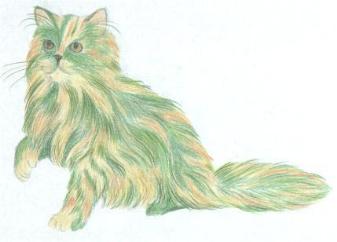
The Green Shaded Silver and Green Chinchilla (genetically closely related to Green Silver Tabby) are also visually appealing, particularly the delicately tipped Chinchilla. The longhair Green Chinchilla is described as "a misty green tint". In the Green Chinchilla and Green Shaded Silver, orange eyes contrast better with the fur colour, so these would more correctly be termed Green Pewter. In the Non-agouti form, the Green Smoke is a darker cat with a pale undercoat, particularly visible at the ruff and britches (area on the back of the legs, just beneath the tail) where the hair tends to be woollier. Some of the Lighter Smokes have very attractive green veiling over an off-white undercoat.
Another interesting result of green's resistance to the dilution gene is seen in tortoiseshell and calico cats. Being an allele of black, green forms tortoiseshells when in combination with the O (red) gene. The full colour green tortie can be an eye-jarring mix of orange and green (more precisely orange, cream and green since all red cats manifest as tabbies). The dilute version, however, is more pleasing to the eye. The dilution gene leaves the green unchanged, but turns red into an attractive cream colour. These green-creams are attractive, especially in combinaiton with the full coat of the Persian.
The effect of the piebald gene breaks up the brindled colours into distinct patches as described in Beautiful Bicolours. The well-defined patches of the green/red/white calico was nicknamed "The Crazy Quilt Cat" by visiting American breeder Robin Schmidt, "Green and ginger just doesn't go."
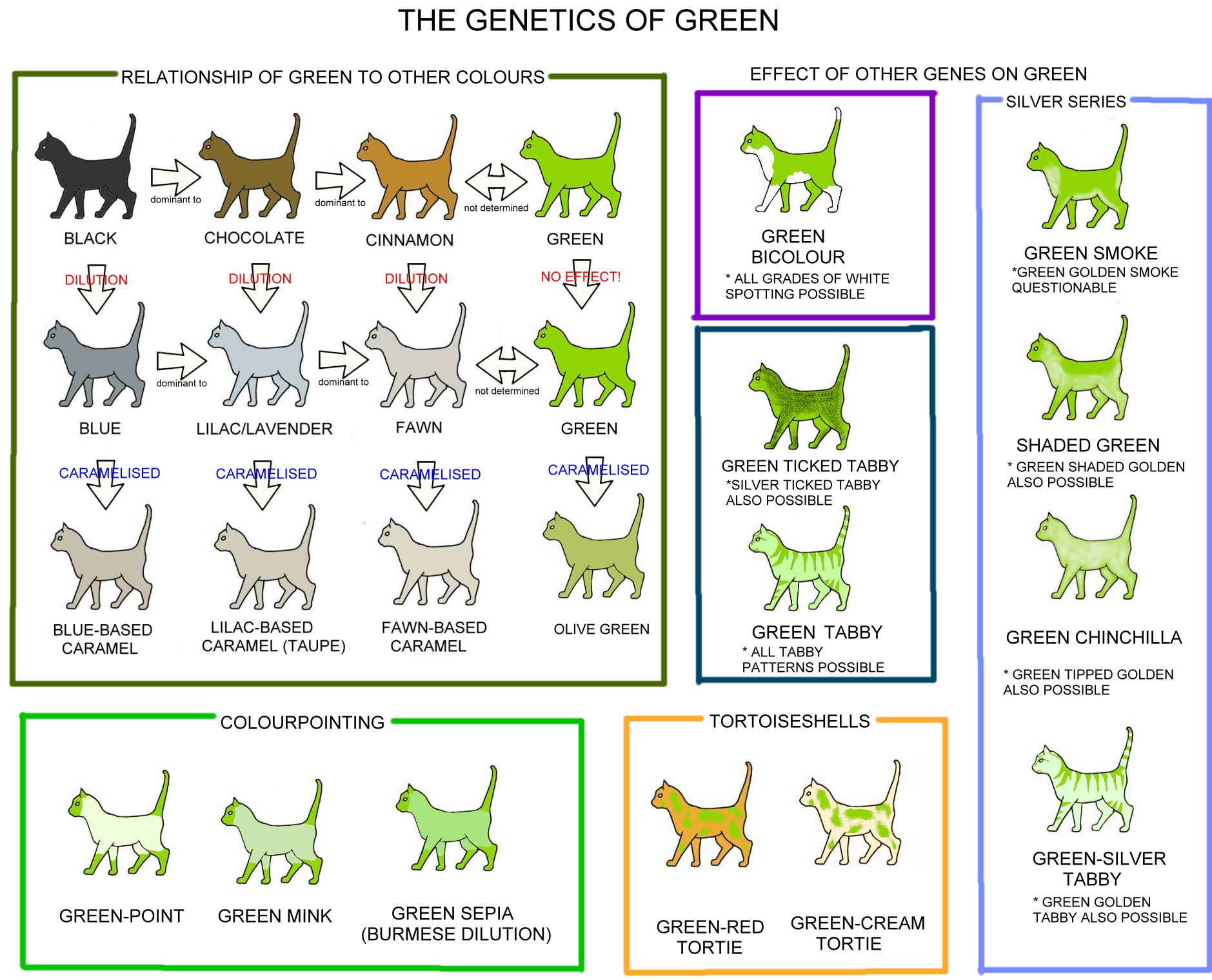
THE FUTURE OF GREEN CATS
Although green has so far been seen in solids, bi- and tri-colours, tabbies, smokes and shaded/tipped cats, so far there have been no experimental green colourpoints (Himalayan or Siamese pattern), green mink (Tonkinese-type); or green sepias (Burmese expression). If the albino gene causing these patterns affects green in the same way as it affects black/chocolate etc, the sepia variety would have leaf-green points and a paler, possibly yellow-green body while the full Siamese-type expression would result in a pastel yellow-green cat with darker points. The effect of mink would be intermediate between these extremes.
Nor has the colour been seen in combination with the Rex or semi-longhair (Angora) hair type.
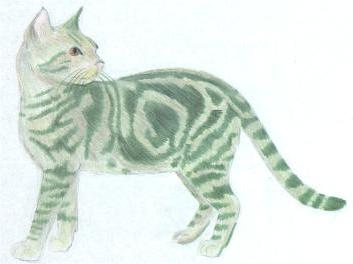
Note: A Dutch breeder of British Colourpoint Shorthairs and Siamese has expressed an interest in developing green points under the name "Greensleeves" (a name chosen in homage to the famous "Sealsleeves" Seal Point Siamese cats of the 1940s), although it is not known whether this will happen in the near future.
Mrs Goddard and a number of other Danish and American cat fanciers are working towards a wholly green breed, tentatively named the Danish Green. The preliminary standard calls for a cat of European Shorthair type with an even grass green colour, although some variation will be accepted on colour (preference given to rich, even colour) and the belly may be a slightly paler shade due to "counter shading". Cats must not have a yellow or grey hue to their fur. Eyes should be orange or hazel to provide contrast with the fur colour. Olive-green fur is penalised; it occurs due to hidden recessives and the cats may still be used in breeding. Acceptable patterns are green self, green bicolour (including Van pattern), green tabbies and green-and-cream/green calico. Silver series is also accepted (Silver Tabby, Smoke, Shaded, Tipped).
Perhaps one of the most outstanding studs in the program to date has been "Bluegrass", a very typey Blue European Shorthair carrying green and dilute. Bred from Grunhilde and an undisclosed Champion Blue European Shorthair, Bluegrass has consistently produced excellent quality kittens with a variety of queens, including back-crossing to Grunhilde herself. Several of his offspring - both blues carrying green and greens - show great promise. In particular, a Bluegrass x Grunhilde cat called "Greengrass" (full expression green carrying dilute) looks set to follow in his sire's footsteps. Green Tea, a daughter of Bluegrass, and half-sister to Greengrass, looks set to become an exceptionally typey female and will hopefully produce some stunning kittens when she reaches breeding age. To prevent excessive inbreeding (and avoid overtyping), typey cats such as Bluegrass, Greengrass and Green Tea will be used mostly with outcross cats to bring in new blood.
During 2003, Absinthe Green Cattery produced several stunning green chinchillas; most notably Absinthe Green Fairy and Absinthe Green Ice; both sired by Crème-de-Menthe (cinnamon carrying green) on his half-sister (lilac carrying green). The breeders are now working the restore the proper Persian conformation which has been affected by outcrossing to introduce the green gene. The long hair of Persians seems to display green to its best effect and the same cattery has bred Greensleeves, the first green-pointed Himalayan as well as numerous self greens.
"It's easy enough to introduce the new colour," said Green Persian enthusiast Christopher-Martin Rhodes of Absinthe Green Cattery, "now we need to get back to the proper Persian type afterwards; especially the ear size and length of nose. Crème-de-Menthe is an excellent stud, but some of his sons show even greater promise as they are closer to the proper conformation as well as having excellent colour. We'd like to produce some green-cream torties, but not until we've got the type right."
Other parties are working on green variants of existing breeds such as Persians and Green Silver Tabby Shorthairs. Whether these will be accepted as new colour divisions of existing breeds, or as separate breeds, will up to individual cat fancies. Some cat enthusiasts would like to see an all-green breed named after St Patrick, the Irish saint's day on which green clothing is traditionally worn and even food and drink are dyed green.
|
Green Smoke |
Green Longhair |
Interested in the green gene or in green cats? The Danish green kitten was real, but was due to copper contamination in local water and her colour was only temporary. For a green breed of cat, I'm afraid you'll have to wait for genetic mutation to catch up with imagination. Happy April Fools Day from Moggycat & messybeast.com !
Not Photoshopped? That's right - none of these photos used Photoshop (TM); Photoshop is a proprietary package, not a verb. None of the cats were dyed. The inheritance genetics of the hypothetical recessive green gene and its modifiers, however, is fully in accordance with feline genetics.